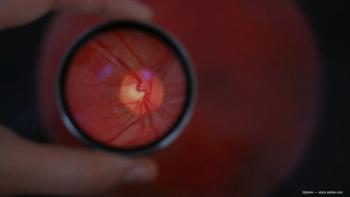
Advice on choosing AREDS or AREDS 2 in non-smokers
In this article, the authors discuss the benefits of nutritional supplementation in preventing AMD progression and consider which AREDS formulation is the most appropriate in smokers and non-smokers.
Take-home message: In this article, the authors discuss the benefits of nutritional supplementation in preventing AMD progression and consider which AREDS formulation is the most appropriate in smokers and non-smokers.
By Dr Paolo Lanzetta, Dr Valentina Sarao and Dr Daniele Veritti
The pathogenesis of AMD is multifactorial, involving oxidative stress as well as genetic, inflammatory, and other environmental factors. Lifelong exposure to free radicals and the depletion of essential micronutrients are considered to be the key driving forces in disease progression.
The age-related eye disease study
Several epidemiological studies have hypothesised that people with low levels of antioxidants may be more prone to oxidative damage, which may ultimately lead to AMD.1 Given the lack of definitive evidence for the beneficial effect of antioxidant supplementation and the growing concern of widespread use of unproven, high-dose supplements, the National Eye Institute performed a randomised, multi-centered, placebo-controlled clinical trial designed to assess the impact of an antioxidant and micronutrient combination on the incidence and progression of AMD.
- Category 1 – patients with less than five small drusen and visual acuity of 20/32 or better in both eyes.
- Category 2 – patients with multiple small drusen, single or non-extensive intermediate drusen, pigment abnormalities or any combination of these in one or both eyes with a visual acuity of 20/32 or better in both eyes.
- Category 3 – patients with extensive intermediate drusen, large drusen, or noncentral geographic atrophy with a visual acuity 20/32 or better in at least one eye
- Category 4 – patients demonstrating visual acuity of 20/32 or better in the study eye with the fellow eye exhibiting visual acuity of less than 20/32 due to AMD related either to geographic atrophy involving the center of the macula or choroidal neovascularisation.
The AREDS study found that there was a 27% reduction in risk of disease progression among participants taking AREDS supplements in Categories 3 and 4, within five years. Patients with category 1 or 2 AMD demonstrated a very low risk of progression to advanced AMD (0.4% and 1.3%, respectively). Due to the low event rate, it was not possible to establish a treatment effect of the AREDS formulation for these participants. The overall risk of moderate vision loss (three or more lines) was reduced by 19% at five years.2
Disease-modifying treatment and AREDS 2
Since publication of the AREDS results, several observational data had emerged suggesting a potential disease-modifying role for omega-3 fatty acids and macular xanthophylls lutein and zeaxanthin in patients affected by AMD. Neither carotenoid was commercially available at the launch of the first AREDS study. Consequently,
Investigators reported that the addition of lutein and zeaxanthin and/or omega-3 fatty acids to the original AREDS oral supplement formulation had no statistically significant effect on progression to advanced AMD.
Beta-carotene in smokers vs non smokers
In a second randomisation, the AREDS 2 study tested the effect of eliminating beta-carotene from the AREDS formulation on the progression of AMD. As beta carotene was suspected to increase the risk of lung cancer in cigarette smokers, patients identified as non smokers (either currently not smoking or former smokers) were randomly assigned to receive 1 of 4 variations of the original AREDS formulations that included either: a) elimination of the beta-carotene component, b) a lowering of the zinc dose, or c) both.
The addition of antioxidants lutein and zeaxanthin appeared to have some benefit in reducing the risk of developing advanced AMD in the subgroup of patients who received the AREDS supplement without beta-carotene. Compared with the original AREDS formulation, adding lutein and zeaxanthin to an AREDS formula without beta-carotene yielded a significant 18% reduction in the risk of progression to advanced AMD (P = 0.02).
The investigators highlighted that lutein, zeaxanthin and beta-carotene could compete with each other for absorption. Therefore, the lack of an overall effect on the risk of advanced AMD after the addition of lutein and zeaxanthin to the original AREDS formulation may be due to the presence of beta-carotene limiting the absorption of lutein and zeaxanthin, as confirmed by blood analysis.3
Lutein and zeaxanthin supplementation
The AREDS 2 trial also reported that the patients who would benefit the most from lutein and zeaxanthin supplementation are those with the lowest dietary intake levels of these two carotenoids. Within that group, subjects who received lutein and zeaxanthin exhibited a 26% reduced risk of progressing to advanced AMD compared with those who did not receive those supplements.
Addition of lutein and zeaxanthin to the AREDS formula without beta-carotene provided benefits in visual acuity improvements. Compared to the original AREDS supplementation, participants who received lutein and zeaxanthin without beta carotene experienced a reduction in moderate visual loss and in the risk of progressing to legal blindness at 5 years by 16% and 18%, respectively.
Finally, while no increased lung cancer risk was seen in patients receiving lutein and zeaxanthin, the trial results showed that a greater percentage of patients assigned to beta-carotene did develop lung cancer (n = 23 [2.0%] vs 11 [0.9%]; P = 0.04). Thirty-one (91%) of participants who developed lung cancer were former smokers.
Clinical implications of the AREDS results
In the AREDS I trial, dietary supplementation with the AREDS formulation has shown clear benefit in patients with intermediate and advanced AMD. However, the original AREDS formulation did confer an increased risk of lung cancer development in current non-smokers or former smokers due to the beta-carotene supplementation.
Lutein and zeaxanthin, the major components of macular pigment, may reduce the risk of developing late AMD by preventing damage from oxidation and harmful wavelengths of light. It is therefore important to improve the safety of the AREDS supplements by removing beta-carotene to decrease the risk of lung cancer, both in smokers and in non-smokers. According to the AREDS 2 results, lutein and zeaxanthin are safer than beta-carotene and therefore they should replace it in the original AREDS formula, regardless of smoking status.
References:
- R. Goralczyk. Nutrition and Cancer 2009; 61(6): 767–774.
- Age-Related Eye Disease Study Group. Arch. Ophthalmol., 2001; 119: 1417-1436.
- The Age-Related Eye Disease Study 2 (AREDS2) Research Group. JAMA. 2013; 309(19): 2005-2015.
Dr Paolo Lanzetta, Dr Valentina Sarao and Dr Daniele Veritti
Paolo Lanzetta is a consultant for Alcon, Alimera, Allergan, Bausch & Lomb, Bayer, Genentech, Novartis, Roche and Teva. Valentina Sarao and Daniele Veritti declare that they have no conflict of interest.
Newsletter
Don’t miss out—get Ophthalmology Times updates on the latest clinical advancements and expert interviews, straight to your inbox.








































